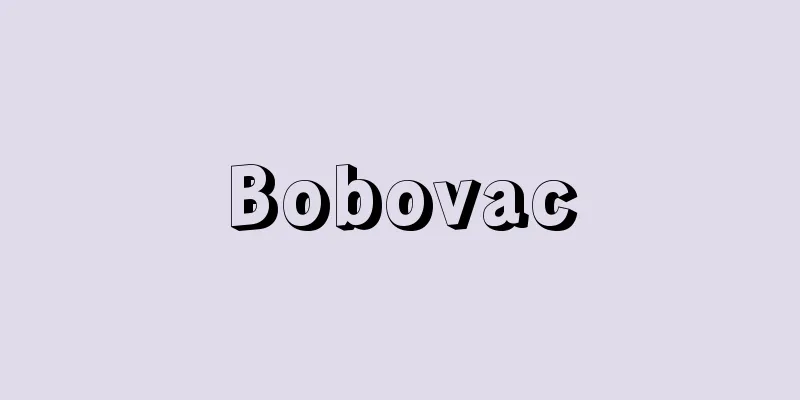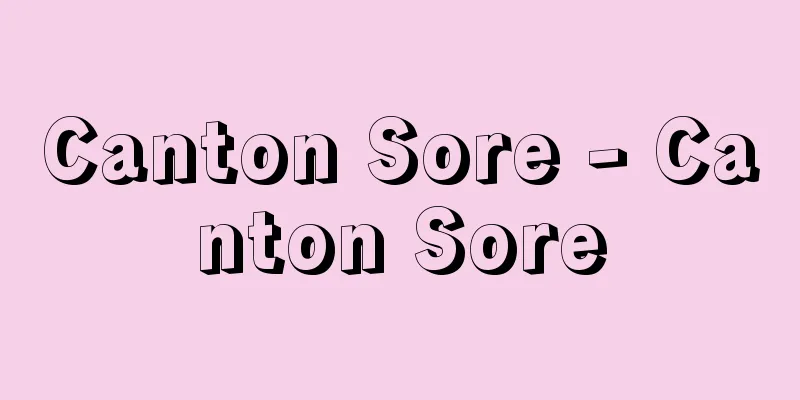Dormancy - Kyumin

|
This refers to the phenomenon in which the development and activity of living organisms temporarily ceases or comes to a near halt in environments that are unsuitable for survival, such as heat, cold, or dryness. plantIt is seen in seeds, spores, tree buds, tuber buds (buds that emerge from underground), and bacterial spores. In general, during dormancy, metabolic activity is kept extremely low, and in many cases, water content is low. This is thought to be a form of adaptation to unfavorable environmental conditions such as low or high temperatures. Dormancy in plants can be divided into seed dormancy and winter bud dormancy for tree buds, tuber buds, etc. [Masayuki Katsumi] Seed dormancySeed dormancy can be caused by the embryo or the seed coat. In the former case, the embryo falls to the ground morphologically immature, and a period of embryo development is required before it can germinate. Seeds of ginkgo, buttercup, ash, and hepatica belong to this category, and depending on the species, it can take anywhere from 10 days to several months for the embryo to fully develop. Also, there are seeds whose embryos are mature but will not germinate immediately after harvest, but will be able to germinate if left at room temperature and in a dry environment for several days to several months. On the other hand, in the latter case, the seed coat is hard and difficult for water to penetrate, as in some seeds of the legume and mallow families, or the seed coat is impermeable to oxygen, as in the case of dormant cocklebur seeds. The dormancy of these seeds is broken when the seed coat is removed or damaged. In natural conditions, the seed coat is broken by decomposition by soil microorganisms or damage by sand or pebbles, etc., which enables germination. Seed dormancy can also be caused by the presence or absence of plant hormones, such as growth inhibitors (mainly abscisic acid) or growth promoters (gibberellins and cytokinins).Some seeds (such as hazel, primrose, apple, rose, and maple) remain dormant unless they experience a period of low temperature, which is thought to be related to fluctuations in plant hormones. When a seed that has become capable of germination becomes dormant again due to a change in conditions, this is called secondary dormancy. [Masayuki Katsumi] Winter bud dormancyIn many temperate deciduous trees, the growth of the terminal and lateral buds stops from summer to autumn, and winter buds (buds that go dormant in winter) wrapped in bracts are formed. This is not due to a change in temperature, but in most cases is due to a change in day length. That is, the terminal bud continues vegetative growth under long-day conditions, but as the days become shorter, growth slows down and eventually stops completely, becoming a dormant bud. The dark period is also important in this photoperiodic response, but this is not as clear as in flower bud formation. It is believed that plant hormones such as abscisic acid and gibberellin are also involved in bud dormancy. The same can be said for tuber sprouts. For example, potatoes do not germinate immediately after harvest because they contain a large amount of abscisic acid and little gibberellin. [Masayuki Katsumi] animalThis includes hibernation and estivation in animals, the narrow sense of dormancy in insects, and dormancy in the form of cysts in protozoans and resistant eggs (winter eggs) in rotifers and water fleas. Animals in a dormant state maintain a very low level of metabolic activity, do not require water or food, and are highly resistant to dryness, low temperatures, or high temperatures. Many animals wake up from dormancy and resume activity when environmental conditions improve. In insects, diapause (diapause in the narrow sense) refers to the autonomous cessation of development controlled by the endocrine system, as opposed to the temporary cessation of development caused by direct external influences such as cold. In this case, development may not progress even in an environment suitable for growth. To wake up from diapause, an insect must be exposed to low temperatures for a certain period of time. Insects overwinter at various developmental stages, such as egg, larva, pupa, and adult, but generally cannot survive winter unless they are in a diapause state. Generally, diapause occurs only once in their life cycle, and the developmental stage at which diapause occurs is consistent depending on the species, and this works to ensure that the developmental stages of individuals of the same generation are synchronized in time. The induction of diapause is dependent on the photoperiod (day length), but there is a time interval between the decision to diapause and its onset, and between the onset and the onset of winter. Adults of univoltine silkworms lay diapause eggs, while multivoltine silkworms lay non-diapause eggs. In bivoltine silkworms, adults from eggs laid in summer lay diapause eggs. High summer temperatures are the main factor inducing diapause, but diapause hormone secreted from the subesophageal ganglion acts directly on the developing ovaries to produce diapause eggs. In the diapause pupae of cecropiasan (a type of wild silkworm representative of the United States), diapause is not caused by diapause hormones, but rather the pupa remains in the form of a pupa because metamorphosis hormones are not secreted. When a diapause pupa is exposed to low temperatures for a certain period of time, the brain becomes activated, prothoracic gland-stimulating hormone is secreted, and the pupa progresses to adulthood, ending diapause. The yolk of diapausing silkworm eggs contains a large amount of glycogen, but when diapause begins, the amount of glycogen rapidly decreases and is converted into glycerol (glycerin) and sorbitol (both sugar alcohols). During larval, pupa, and adult diapause (for example, the pupal diapause of the Cecropia san), glycogen is converted into sugar alcohols in the fat body. Glycerol is accumulated in the bodies of many overwintering insects, and glycerol and sorbitol are strong antifreeze agents that protect cells from low-temperature damage and contribute to frost resistance. When diapausing silkworm eggs wake up from diapause, the amount of glycogen synthesized from glycerol and sorbitol increases. In diapausing pupae of the C. shinjusan, glycogen is converted into trehalose. Trehalose is an important substance as a stored carbohydrate and an energy source. Glycogen and sugar alcohols, and glycogen and trehalose are converted into each other depending on the temperature, which is energy economical. [Keiichi Onoyama] "Plant Physiology" by Masuda Yoshio (1988, Baifukan) " ▽ "Growth Regulation of Fruit Trees" edited by Yamazaki Toshihiko et al. (1989, Hakuyusha)" ▽ "New Fabre's Book of Insects" edited by the Chemical Society of Japan (1991, Dainippon Tosho) ▽ "Basic Biology Course 6: Development and Morphological Formation" edited by Ota Jiro et al. (1991, Asakura Shoten)" ▽ "Seasonal Adaptation and Diapause in Insects" edited by Takeda Makio and Tanaka Seiji (1993, Bun-ichi Sogo Shuppan)" ▽ "My Research: How Do Insects Survive Winter?" by Kayano Haruo and Shimoda Tomomie (1995, Kaiseisha)" ▽ "Insects - The Secret of Psychic Powers" edited by Nishida Ikuo (1996, Kyoritsu Shuppan)" ▽ "Convenient Handbook for Persimmon Work - How to Eliminate Small Fruits and Bad Years" by Muramatsu Hiroyuki (1996, Rural Culture Association)" ▽ "The Natural History of Weeds - The Ecology of Toughness" edited by Yamaguchi Hirofumi (1997, Hokkaido University Press)" ▽ "Molecular Biology of Hormones 8: Hormones of Invertebrates" edited by the Japanese Society for Comparative Endocrinology ( 1998, Society Publication Center)" ▽ "Biology of Spider Mites - From Basic Research to Applications" by Takafuji Akio (1998, Springer-Verlag Tokyo)" ▽ "Seed Biology" by Suzuki Yoshihiro (2003, Tohoku University Press) [References] | | | | | | | | | | | | | | | | | | | | |Source: Shogakukan Encyclopedia Nipponica About Encyclopedia Nipponica Information | Legend |
|
生物の発生や活動が、暑さ、寒さ、乾燥など生存に不適な環境において、一時的に停止または停止に近い状態になる現象をいう。 植物種子、胞子、樹芽、塊茎芽(地下部から出る芽)などや細菌の胞子などでみられる。一般に休眠状態では代謝活動はきわめて低く保たれ、多くの場合、含水量は低い。これは、低温や高温など好ましくない環境条件への適応の形であると考えられる。植物の休眠は種子休眠と、樹芽、塊茎芽などの冬芽休眠に分けることができる。 [勝見允行] 種子休眠種子休眠は胚(はい)に原因がある場合と、種皮に原因がある場合とがある。前者には胚が形態的に未熟なまま地上に落ちるため、発芽が可能となるまで胚の発育の期間を必要とするものがある。イチョウ、キンポウゲ、トネリコ、スハマソウなどの種子がこれに属し、胚の発育完了まで種によって10日から数か月かかる。また、胚は成熟しているが、収穫直後は発芽せず、室温、乾燥状態で数日から数か月放置されると発芽能力をもつ種子がある。 他方、後者ではマメ科やアオイ科などの一部の種子にみられるように、種皮が堅くて水が透過しにくいか、オナモミの休眠種子のように種皮の酸素不透過が原因となる。これらの種子は種皮を取り除くか、傷をつけてやると、休眠は破れる。自然の状態では土壌微生物による種皮の分解、あるいは砂、小石などによる損傷が発芽を可能にする。 種子の休眠には成長阻害物質(主としてアブシシン酸)や成長促進物質(ジベレリン、サイトカイニン)などの植物ホルモンの有無が原因の場合もある。種子のなかで、低温期を経験しない限り休眠を続けるもの(セイヨウハシバミ、サクラソウ、リンゴ、バラ、カエデなど)があるが、低温期は、植物ホルモンの変動と関係があると考えられる。 発芽可能になった種子が、条件の変化でふたたび休眠するとき、これを二次休眠という。 [勝見允行] 冬芽休眠温帯の落葉樹の多くは、夏から秋にかけて、頂芽や側芽の成長が停止し、苞(ほう)によって包まれた冬芽(冬に休眠する芽)が形成される。これは温度の変化によるものではなく、ほとんどの場合、日長の変化に起因する。すなわち、頂芽は長日条件だと栄養成長を継続するが、短日になるにしたがって成長は遅くなり、ついには完全に停止して、休眠芽となる。この光周反応は、やはり暗期がたいせつであるが、花芽形成におけるほど明確ではない。 芽の休眠にもアブシシン酸、ジベレリンなどの植物ホルモンが関与しているものと考えられている。塊茎芽の場合も同じように考えられる。たとえば、ジャガイモは収穫直後は発芽しないが、これは多量にアブシシン酸が含まれ、ジベレリンが少ないためである。 [勝見允行] 動物動物の冬眠や夏眠、昆虫の狭い意味での休眠、原生動物の被嚢(ひのう)胞子やワムシ、ミジンコなどの耐久卵(冬卵)の状態での休眠が含まれる。休眠状態にある動物は、代謝活動のレベルが非常に低く保たれ、水や食物を必要とせず、乾燥や低温あるいは高温に対する抵抗性が強くなっている。多くの動物では、環境条件がよくなれば休眠から覚めて活動を再開する。 昆虫では、寒冷などの外的な作用に直接的影響を受けて一時的に発育を停止する場合に対して、内分泌系の支配による自律的な発育の停止を休眠(狭義の休眠)といっている。この場合、発育に適した環境下でも発育が進まないことがある。休眠から覚めるには、低温に一定期間さらされる必要がある。昆虫では、卵、幼虫、蛹(さなぎ)、成虫のいろいろな発育段階で越冬するが、普通、休眠状態でないと越冬できない。一般に休眠期は生活史のなかで1回だけで、種によって休眠が行われる発育段階が一定しており、同世代の個体の発育段階が時期的にそろうように働いている。休眠の誘起は光周期(日長)によるが、休眠の決定時と開始時、開始時と冬の到来の間にはそれぞれ時間間隔がある。 カイコの年一化性の品種の成虫は休眠卵を産み、多化性のカイコは非休眠卵を産む。二化性のカイコでは、夏に産まれた卵からの成虫は休眠卵を産む。夏の高温が休眠をおこすおもな因子であるが、直接には食道下神経節より分泌される休眠ホルモンが、発育中の卵巣に働いて休眠卵をつくる。セクロピアサン(アメリカを代表する野蚕(やさん)の一種)の休眠蛹(よう)では、休眠ホルモンによって休眠がおこるのではなく、変態ホルモンが分泌されないために蛹のままでいる。休眠蛹が低温に一定期間さらされると、脳が活性化し、前胸腺(きょうせん)刺激ホルモンが分泌されて成虫化へと進むため、休眠が終わる。 カイコの休眠卵には卵黄中に多量のグリコーゲンが含まれているが、休眠が始まるとグリコーゲンは急激に減少し、グリセロール(グリセリン)とソルビトール(いずれも糖アルコール)にかわる。幼虫、蛹、成虫の休眠(たとえばセクロピアサンの蛹休眠)では、脂肪体中でグリコーゲンが糖アルコールにかわる。数多くの越冬昆虫の体内にグリセロールの蓄積がみられるが、グリセロールとソルビトールは強力な不凍剤で、細胞を低温傷害から保護し、耐凍性に役だっている。カイコの休眠卵が休眠から覚めると、グリセロールとソルビトールから合成されたグリコーゲンが増加する。シンジュサンの休眠蛹ではグリコーゲンはトレハロースに転換される。トレハロースは貯蔵炭水化物として重要な物質でエネルギー源となる。グリコーゲンと糖アルコール、グリコーゲンとトレハロースは温度に依存して相互に転換し、エネルギー的に経済的である。 [小野山敬一] 『増田芳雄著『植物生理学』(1988・培風館)』▽『山崎利彦ほか編著『果樹の生育調節』(1989・博友社)』▽『日本化学会編『新ファーブル昆虫記』(1991・大日本図書)』▽『太田次郎ほか編『基礎生物学講座6 発生と形態の形成』(1991・朝倉書店)』▽『竹田真木生・田中誠二編『昆虫の季節適応と休眠』(1993・文一総合出版)』▽『茅野春雄文、下田智美絵『わたしの研究 虫はどのように冬を越すのか?』(1995・偕成社)』▽『西田育巧編『昆虫――超能力の秘密』(1996・共立出版)』▽『村松博行著『カキの作業便利帳――小玉果・裏年をなくす法』(1996・農山漁村文化協会)』▽『山口裕文編著『雑草の自然史――たくましさの生態学』(1997・北海道大学図書刊行会)』▽『日本比較内分泌学会編『ホルモンの分子生物学8 無脊椎動物のホルモン』(1998・学会出版センター)』▽『高藤晃雄著『ハダニの生物学――基礎研究から応用へ』(1998・シュプリンガー・フェアラーク東京)』▽『鈴木善弘著『種子生物学』(2003・東北大学出版会)』 [参照項目] | | | | | | | | | | | | | | | | | | | | |出典 小学館 日本大百科全書(ニッポニカ)日本大百科全書(ニッポニカ)について 情報 | 凡例 |
Recommend
San language - Sango (English spelling)
A language spoken by the San (also known as Bushme...
Yangmingism - Yomeigaku
The scholarship of the Wang Yangming School in th...
discriminatory price policy
In addition to these basic pricing policies, ther...
Kakeyama style pottery - Kakeyamashi Kidoki
...A settlement site from the late Yayoi period t...
Nahapāna (English spelling)
…The two most powerful Kshatrapa powers were (1) ...
Ladder fern
An evergreen fern of the Laminaceae family. It gr...
Monogamy - monogamy
… [Toru Ariji] [Christianity and Marriage] For Ch...
Butterbur - Fuki
The name of a koto piece. It is also written as &q...
Oporto - Oporto (English spelling)
The English name of the city of Porto in northwes...
Feijoada
A Brazilian dish. It originated from the colonial ...
Rites of passage - les rites de passage (English: Rites of passage) (French)
A person's life consists of several stages, s...
Al-`Aqabah (English spelling)
A port city at the southern tip of Jordan. Located...
Burnt Norton
…Published in 1943. It consists of four chamber m...
Reduviidae
...A general term for insects belonging to the or...
International Accounting Standards
Accounting standards created by the International ...









